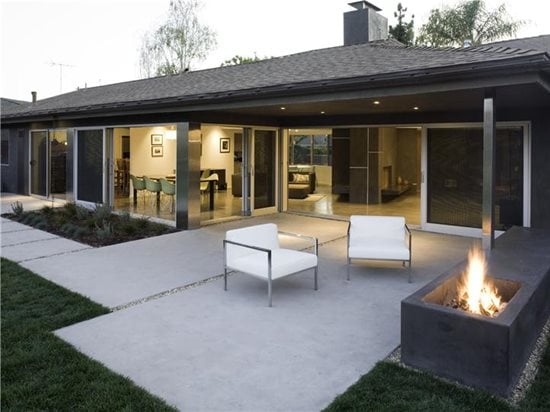
For this patio, strips of decorative gravel offer an attractive drainage solution. Modal Design in Los Angeles, CA.
Do portions of your concrete patio or pool deck sit under water after a heavy rain, ruining your outdoor activities? That’s a sure sign that your patio isn’t draining properly. Poor patio drainage not only spoils your outdoor fun, it can also allow water to seep into your basement if the water pools next to your house. Here are some tips for identifying and correcting aggravating and potentially destructive patio drainage problems.
Why is Water Pooling on my Concrete Patio?
Here are the most common causes for patio drainage problems:
Improper slope.
If your patio is completely flat and has low spots where the water collects, it needs to be angled or sloped slightly so the water will run off the surface, much like a roof gutter is sloped to direct water to the downspout.
Find concrete patio contractors near me who can assess and fix my drainage problems.
Clogged drainage system.
If your patio used to drain well after a heavy rain, but now seems to collect water, you may have a clogged drainage system. Over time debris can collect in the drainage channels and cause a blockage.
Roof overhangs and downspouts.
If rainwater is flowing directly onto your patio from a roof overhang or downspout, the water will pool in that area quickly. Installing a gutter system and redirecting downspouts away from the patio will usually correct the problem.

The pitch of a patio can be corrected using an overlay, as was done on this project. Unique Concrete in West Milford, NJ.
Patio Drainage Systems for New and Old Concrete
What are the solutions for existing patios?
If you have an existing concrete patio that does not have a drainage system, it’s not too late to install one. Where the water tends to collect, cut out a sloping channel in the concrete to direct the water away, filling it with decorative stone or gravel.
Instead of gravel, you can also have a trench or channel drain made of metal installed. These drains are typically just a few inches wide and allow water to pass through, but keep out debris. They are installed flush with the surrounding patio so they won't be a triping hazard.
A more radical yet effective solution is to reestablish the pitch of the patio slab by installing a cement-based overlay. On this project, the pitch of the patio was corrected by installing an overlay ranging from 4 inches down to under an inch. The overlay was placed in sections separated by integrally colored borders to add decorative interest and to eliminate the need for sawcuts.
How do I prevent poor drainage when putting in a new patio?
The best way to prevent patio drainage problems is to plan for them when the slab is installed. If your landscape prevents you from pitching the patio to allow for natural water runoff, your concrete contractor can install an in-slab drainage system with gravel-filled channels to carry the water away. A more attractive option is to place the patio slab in sections with strips of decorative gravel or groundcover in between. (See this example.)
Another possibility is to build your patio using permeable or porous concrete pavers, which allow water to percolate through the patio into the ground below. This solution can also benefit your surrounding landscape by reducing the amount of stormwater runoff and erosion.